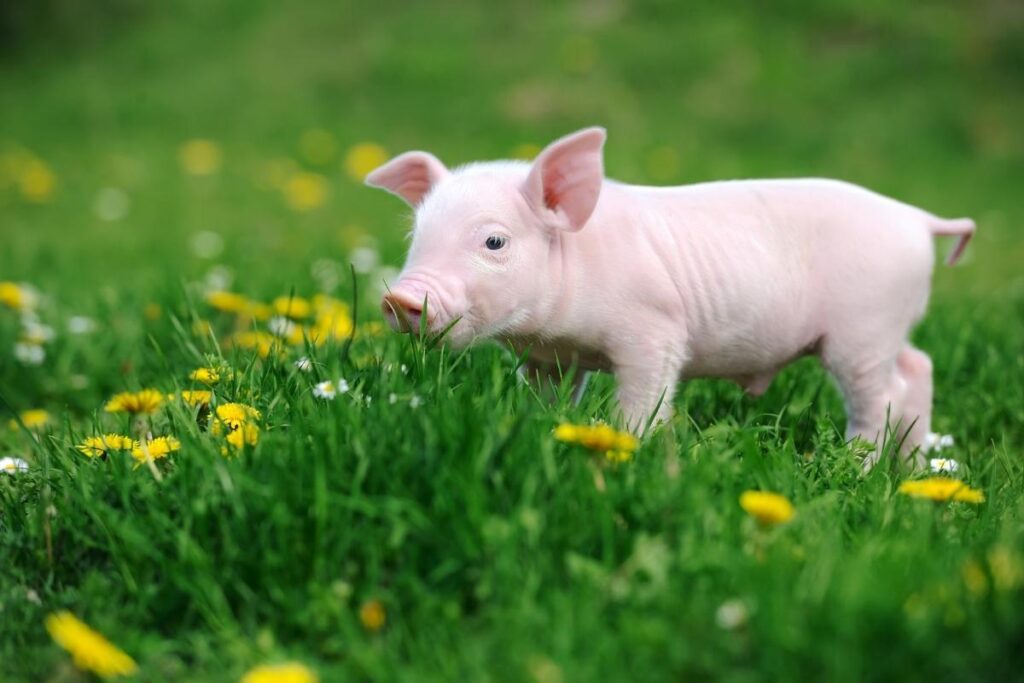
Thanks to a very clever spider, E.B. White’s fictional porcine protagonist lived to a ripe old age, but if you are considering raising a real-life Wilbur or two of your own, whether for pork production or as a snuffling family pet, you might be wondering just how long do pigs live? While there are multiple factors that can affect the longevity of pigs, you can expect an average life span of fifteen to eighteen years from your porky pal. Of course, there are always a few outliers. A pot-bellied pig named Baby Jane, lived to be 23 years old and Snout, the oldest pig currently alive, is reported to be a whopping twenty-four years old. Now, that’s “some pig”!
Some “Terrific” Pig Breeds and How Long Do Pigs Live, Really?
There is a wide variance in the average lifespan of a pig when you compare those raised for commercial purposes, wild pigs, and those kept as pets. Obviously, those bred for commercial purposes will have the shortest lifespan of the three, typically meeting their end by six months of age. These are no small animals, mind you. At six months, the average hog can tip the scales at near three hundred pounds.
Experts conclude that while some wild pigs can live to twelve years old, the average lifespan tops out between six and eight years. Beyond the age of four, a wild pig’s mortality rate hikes every year by fifty percent. Factors that contribute to the wild pig’s higher mortality rate are predators, exposure to the elements, lack of healthcare, and food scarcity. A pet pig, on the other hand, enjoys a higher standard of care, receiving a quality, consistent food supply and medical care for any of the health issues that can typically affect swine. As such, you will see pet pigs with lifespans up to twenty years.
There are many different varieties of pig out there, each with its own expected lifespan. You can expect a smaller pig breed to outlive its larger counterparts as lifespan typically decreases the bigger the pig is. That doesn’t mean, however, that a teacup breed will live longer than a traditional breed. Methods of breeding those particular pigs contribute to a genetic makeup that shortens the pig’s life expectancy, but there are many other breeds to choose from with generous lifespans.
Spotted Pig
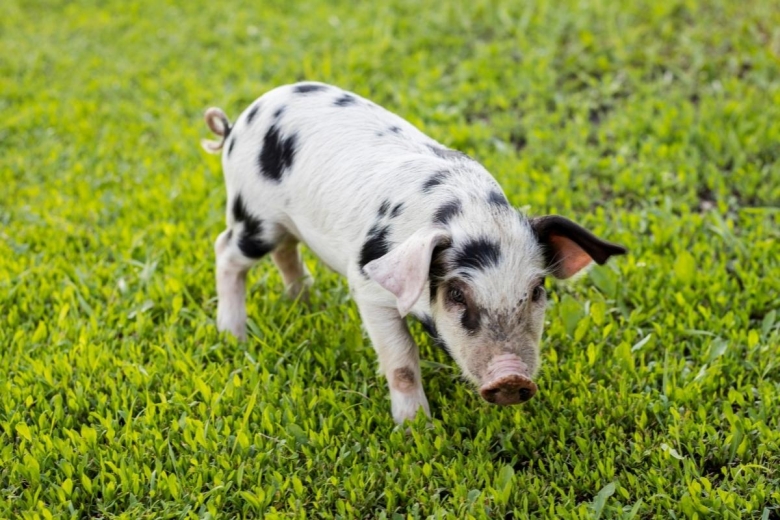
One great traditional breed to consider for longevity is the spotted pig. The spotted pig is named for—you guessed it—its spots! This breed of pig is covered in black and white spots and can live up to twenty years with proper care and feeding.
Duroc Pig
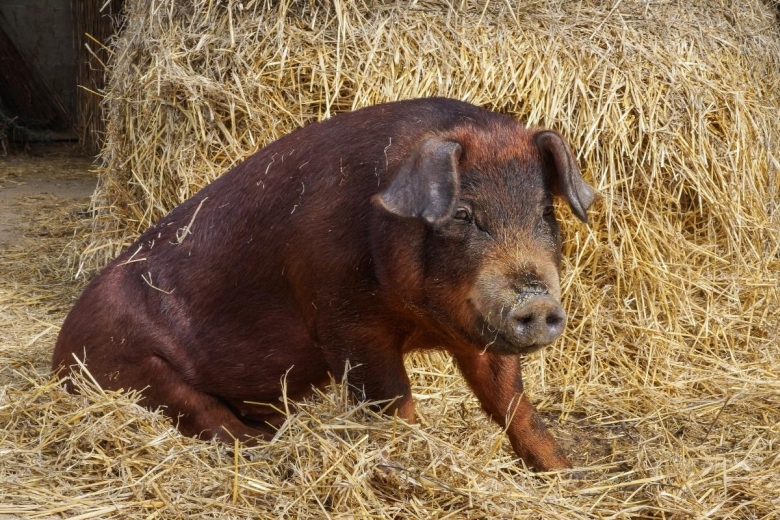
The Duroc comes in a close second, living anywhere from ten to fifteen years. Also known as “the red hog” because of its ruddy skin tone, the Duroc has large, floppy ears. The breed is hardy, readily adaptable to both warm, summer conditions and harsher winters. It has a tough skin covered in generous hair to help it cope with colder temperatures but can also shed its coat to keep cool when the mercury starts to climb.
Hampshire Pig
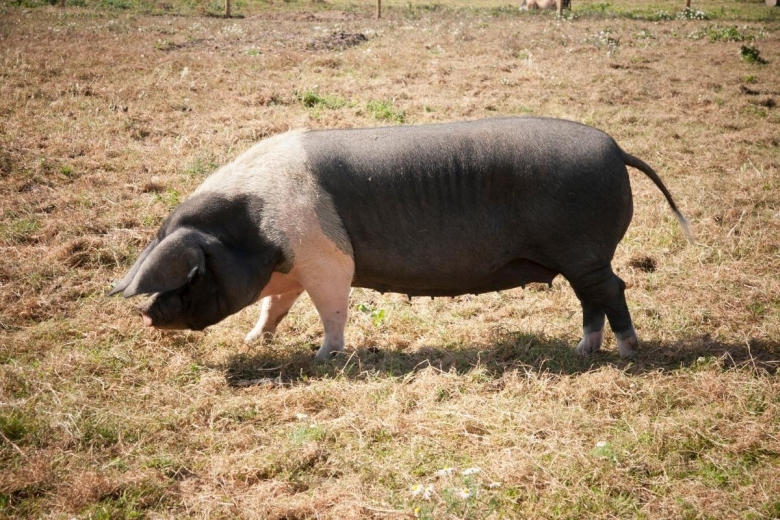
If pigs eavesdropped, the Hampshire pig would be great at it with its characteristic erect ears. The breed also sports a distinctive white band around its otherwise black body. The friendly Hampshire can live up to twelve years. A great choice for exhibition, these pigs prefer a cleaner living environment than some of its counterparts. No pigsties for this porker!
Yorkshire
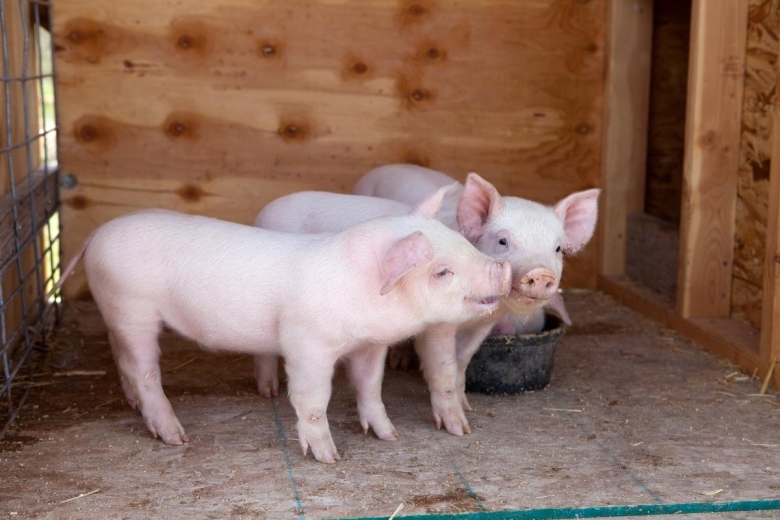
While the Yorkshire is a popular pig with farmers, this breed needs ample space to move about. As such, it may not be the best choice for smaller farms or domestic spaces. This white-skinned pig, first bred in the United Kingdom, is fairly easygoing. They typically live anywhere from eight to ten years on average.
Berkshire
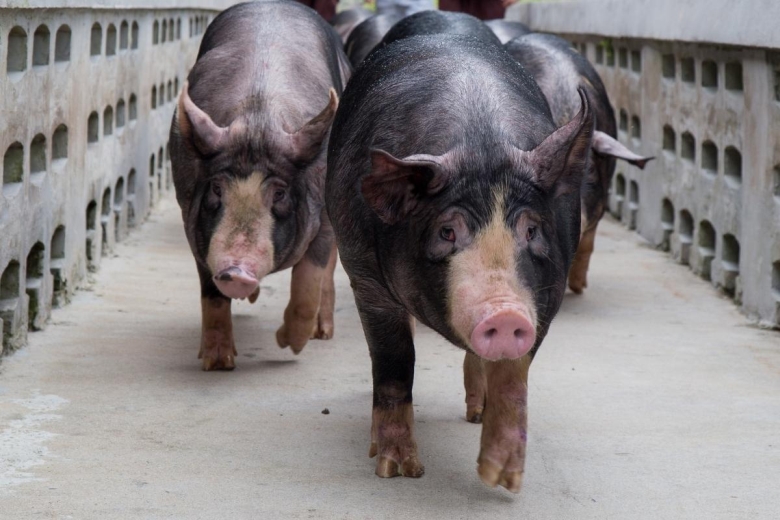
The Berkshire is a mostly black pig, originally bred in England. While considered rare in the UK, countries where it has been exported, such as the United States, Australia, New Zealand, and Japan see higher numbers. It is a good-sized pig, reaching between 500 and 600 pounds. It enjoys a lifespan of up to ten years.
Landrace

The Landrace pig was originally bred in Denmark but has since been cross bred to weed out some of the health issues that plagued the original breed. This white-skinned pig can reach a whopping 700 pounds. The Landrace sow is known for producing large litters. It is usually bred for pork production but, if raised as a pet, can live around six and up to ten years.
Poland China Pigs
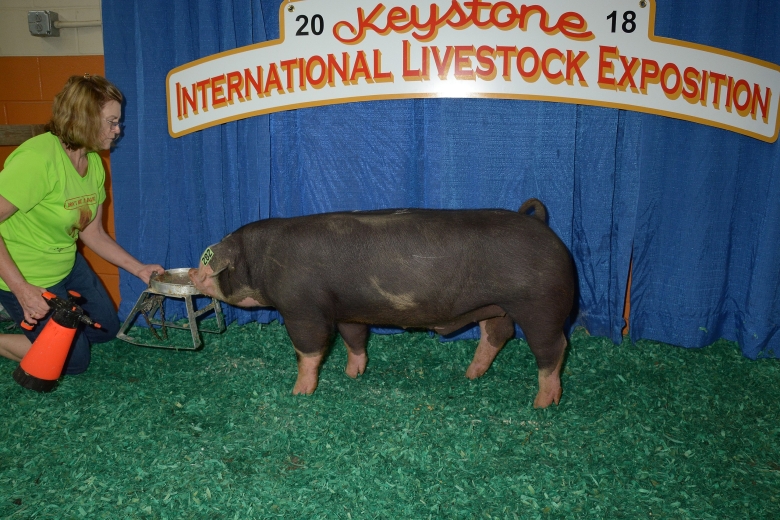
The Poland China breed was not bred in Poland nor China though its ancestors may have hailed from those parts. This breed comes out of the American Midwest from Warren County, Ohio. The Poland China pig derives from a crossbreeding of various pigs from China and the English Berkshire among others. It, too, typically lives between six and ten years.
How to Keep Your Pig in “Radiant” Health
While domestic pigs do, on average, live longer than their feral counterparts, there is still a host of factors that can affect your pig’s lifespan. Besides the pig’s breed, this also includes size, living conditions, nutrition, and susceptibility to common diseases known to plague pigs.
Digestive Issues
You could name your hog “Hoover” and you wouldn’t be that far off the mark. A pig sucks up just about anything—whether or not it should! This can lead to a variety of digestive tract issues that can affect your pig’s longevity if not immediately addressed. This can be anything from an obstruction in the digestive tract to a rupture, either of which can result in death if not treated.
Pigs aren’t too particular when it comes to being sanitary, either. This means that they are susceptible to picking up harmful bacteria such as E. coli and salmonella which can lead to inflamed gut, diarrhea, weakness and, if untreated, death.
Something to keep in mind, particularly if your pig is kept primarily indoors, is to ensure adequate hydration. If your pig doesn’t receive enough water on a regular basis, it can experience dehydration. Over time, this can become severe, resulting in something called “rectal prolapse,” a condition where a portion of the gut protrudes from the body. This particular condition can be extremely painful and deadly if not addressed.
Bone and Joint Problems
The heavier a pig gets, the more likely it will experience issues with its bones and joints. This could be anything from a broken bone or displaced joint that occurs from a fall to an infection resulting from improper hoof care. But there are things you can do to help alleviate some of these issues.
First, while it is important to ensure your pig receive adequate nutrition, you don’t want them to “pig out”. The heavier a pig is, the more stress is put on bones and joints to support that weight. As your pig ages, any excess weight can also exacerbate conditions like arthritis, drastically reduces your pig’s quality and, ultimately, longevity of life.
Second, pay attention to the condition of your pig’s hooves. Pig hooves are constantly growing and need periodic tending. Should a pig’s hooves become too long, they can experience unwanted cracking, leaving them susceptible to infections. Treat your piggy’s piggies to a manicure regularly to keep them in the pink.
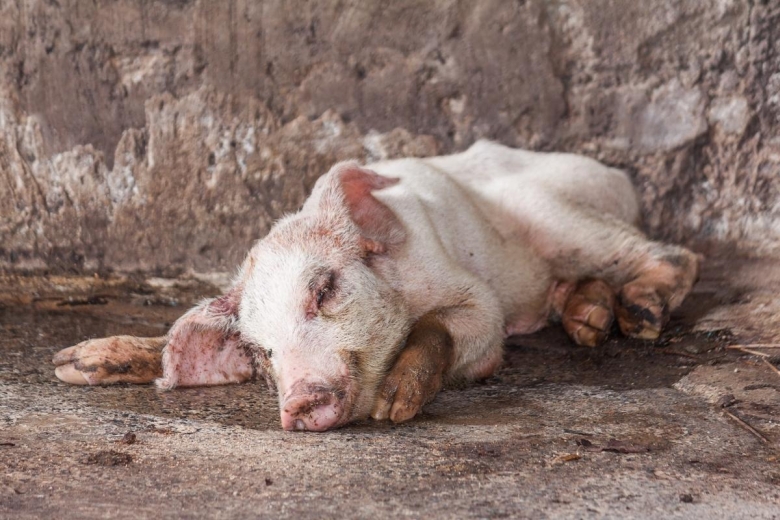
Neurological Issues
Have you ever heard the expression “sweat like a pig”? That’s a fallacy. While humans sweat as a means to reduce their internal body temperature, pigs are incapable of sweating. When exposed to humid temperatures in the mid-eighties and above, a pig’s body temperature can spike dramatically resulting in severe damage to their brain and potential death.
Some neurological diseases can develop in pigs, such as congenital ataxia, streptococcal meningitis, and others which, if left untreated, can cause swine death. Monitor your pig regularly, looking for abnormal behaviors like trembling, incoordination, or seizure-like activity that can be indicative of these issues.
Dehydration can also cause some of these symptoms. It can also cause a condition called “salt toxicity.” When a pig becomes severely dehydrated, it can cause a dangerous imbalance in the pig’s fluid-salt ratio. It acts as a poison which affects the pig’s brain. To avoid this issue, ensure your pig is adequately hydrated.
Respiratory Issues
Pigs can sneeze, too. Like humans, the rhinitis virus can affect pigs and, while a sneeze may send a human reaching for the tissue box, it can cause all sorts of issues for a pig. Repeated uncontrolled sneezes in a pig can cause nosebleeds and even permanently contort a pig’s nasal passages which can affect the pig’s respiratory ability. Pigs can be vaccinated for the condition. However, it can only be done while in utero.
Like humans, too, pigs are susceptible to pneumonia. Usually picked up as bacteria infects the respiratory tract, pneumonia in pigs can be treated with antibiotics if caught early enough, but it can lead to premature death.
One respiratory-related illness that pigs can pass along to humans is swine flu. If a pig starts exhibiting symptoms such as a barking cough, goes off its feed, and is running a fever, seek the immediate attention of a veterinarian. As swine flu is transferrable to humans, exercise special caution when handling a suspected infected pig.
Other Issues
There are also some other issues which can affect a pig’s longevity—conditions affecting the skin, like melanomas and diamond-skin, or sub-par living conditions. If, however, you exercise prudent care for your pig, there is no reason why you cannot enjoy a long companionship from this friendly and intelligent creature. It doesn’t take much to keep a pig happy—just regular care, plenty of water, and that’s all folks!
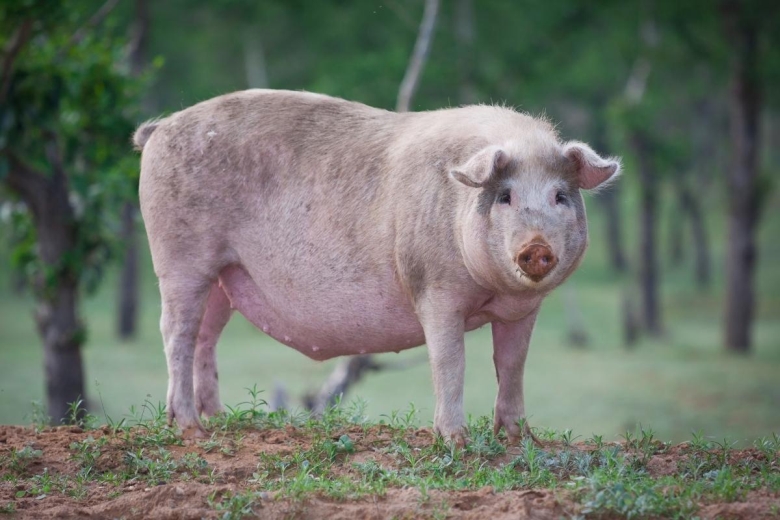
Some “Humble” FAQs
How long can domesticated pigs live?
Pigs that have been domesticated can live, on average, up to fifteen years of age. They have a decided edge over wild pigs as their health and dietary needs are tended.
What is the longest-living pig breed?
If you’re looking to raise a pig as a pet and are willing to make a long-term commitment, consider the Vietnamese Pot-Bellied Pig This breed can live up to twenty years on average. Smaller pigs, particularly the teacup breeds, have markedly shorter lifespans due to their breeding.
How can you determine a pig’s age?
Want to know how many candles to put on your pig’s cake? Look at its teeth. Adult teeth develop in pigs around two years old. You’ll also see tusks develop around this time as well. Observing the amount of wear on the existing teeth will also give a clearer picture of a pig’s specific age. Besides teeth, you can also assess the pig’s weight and growth and compare it to the trends for its particular breed.
